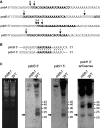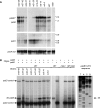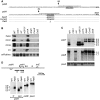Small RNAs reveal two target sites of the RNA-maturation factor Mbb1 in the chloroplast of Chlamydomonas
- PMID: 24335082
- PMCID: PMC3950674
- DOI: 10.1093/nar/gkt1272
Small RNAs reveal two target sites of the RNA-maturation factor Mbb1 in the chloroplast of Chlamydomonas
Abstract
Many chloroplast transcripts are protected against exonucleolytic degradation by RNA-binding proteins. Such interactions can lead to the accumulation of short RNAs (sRNAs) that represent footprints of the protein partner. By mining existing data sets of Chlamydomonas reinhardtii small RNAs, we identify chloroplast sRNAs. Two of these correspond to the 5'-ends of the mature psbB and psbH messenger RNAs (mRNAs), which are both stabilized by the nucleus-encoded protein Mbb1, a member of the tetratricopeptide repeat family. Accordingly, we find that the two sRNAs are absent from the mbb1 mutant. Using chloroplast transformation and site-directed mutagenesis to survey the psbB 5' UTR, we identify a cis-acting element that is essential for mRNA accumulation. This sequence is also found in the 5' UTR of psbH, where it plays a role in RNA processing. The two sRNAs are centered on these cis-acting elements. Furthermore, RNA binding assays in vitro show that Mbb1 associates with the two elements specifically. Taken together, our data identify a conserved cis-acting element at the extremity of the psbH and psbB 5' UTRs that plays a role in the processing and stability of the respective mRNAs through interactions with the tetratricopeptide repeat protein Mbb1 and leads to the accumulation of protected sRNAs.
Figures





Similar articles
-
Small RNA profiling in Chlamydomonas: insights into chloroplast RNA metabolism.Nucleic Acids Res. 2017 Oct 13;45(18):10783-10799. doi: 10.1093/nar/gkx668. Nucleic Acids Res. 2017. PMID: 28985404 Free PMC article.
-
Characterization of Mbb1, a nucleus-encoded tetratricopeptide-like repeat protein required for expression of the chloroplast psbB/psbT/psbH gene cluster in Chlamydomonas reinhardtii.Proc Natl Acad Sci U S A. 2000 Dec 19;97(26):14813-8. doi: 10.1073/pnas.97.26.14813. Proc Natl Acad Sci U S A. 2000. PMID: 11121080 Free PMC article.
-
Stability determinants in the chloroplast psbB/T/H mRNAs of Chlamydomonas reinhardtii.Plant J. 2000 Mar;21(5):469-82. doi: 10.1046/j.1365-313x.2000.00700.x. Plant J. 2000. PMID: 10758498
-
Complex RNA metabolism in the chloroplast: an update on the psbB operon.Planta. 2013 Feb;237(2):441-9. doi: 10.1007/s00425-012-1782-z. Epub 2012 Oct 13. Planta. 2013. PMID: 23065055 Free PMC article. Review.
-
Post-transcriptional regulation of chloroplast gene expression in Chlamydomonas reinhardtii.Plant Mol Biol. 1996 Oct;32(1-2):327-41. doi: 10.1007/BF00039389. Plant Mol Biol. 1996. PMID: 8980486 Review.
Cited by
-
Systematic analysis of plant mitochondrial and chloroplast small RNAs suggests organelle-specific mRNA stabilization mechanisms.Nucleic Acids Res. 2016 Sep 6;44(15):7406-17. doi: 10.1093/nar/gkw466. Epub 2016 May 27. Nucleic Acids Res. 2016. PMID: 27235415 Free PMC article.
-
A nucleus-encoded chloroplast protein regulated by iron availability governs expression of the photosystem I subunit PsaA in Chlamydomonas reinhardtii.Plant Physiol. 2015 Apr;167(4):1527-40. doi: 10.1104/pp.114.253906. Epub 2015 Feb 11. Plant Physiol. 2015. PMID: 25673777 Free PMC article.
-
Pas de Trois: An Overview of Penta-, Tetra-, and Octo-Tricopeptide Repeat Proteins From Chlamydomonas reinhardtii and Their Role in Chloroplast Gene Expression.Front Plant Sci. 2021 Nov 17;12:775366. doi: 10.3389/fpls.2021.775366. eCollection 2021. Front Plant Sci. 2021. PMID: 34868174 Free PMC article. Review.
-
Small RNA profiling in Chlamydomonas: insights into chloroplast RNA metabolism.Nucleic Acids Res. 2017 Oct 13;45(18):10783-10799. doi: 10.1093/nar/gkx668. Nucleic Acids Res. 2017. PMID: 28985404 Free PMC article.
-
Small RNAs from mitochondrial genome recombination sites are incorporated into T. gondii mitoribosomes.Elife. 2024 Feb 16;13:e95407. doi: 10.7554/eLife.95407. Elife. 2024. PMID: 38363119 Free PMC article.
References
-
- Herrin DL, Nickelsen J. Chloroplast RNA processing and stability. Photosynth. Res. 2004;82:301–314. - PubMed
-
- Stern DB, Goldschmidt-Clermont M, Hanson MR. Chloroplast RNA metabolism. Annu. Rev. Plant Biol. 2010;61:125–155. - PubMed
-
- Barkan A, Goldschmidt-Clermont M. Participation of nuclear genes in chloroplast gene expression. Biochimie. 2000;82:559–572. - PubMed
-
- Zerges W. Translation in chloroplasts. Biochimie. 2000;82:583–601. - PubMed
Publication types
MeSH terms
Substances
LinkOut - more resources
Full Text Sources
Other Literature Sources
Molecular Biology Databases

